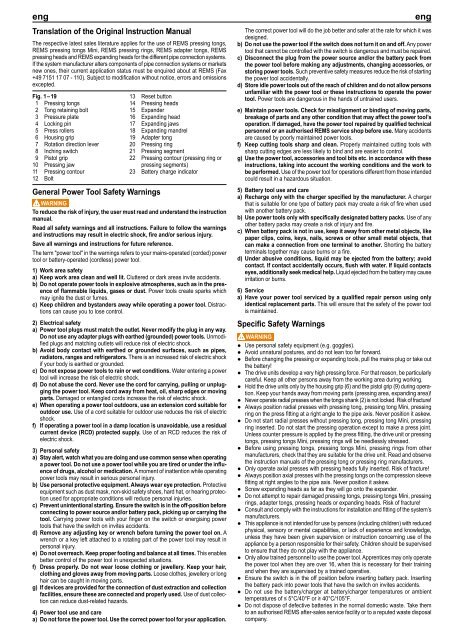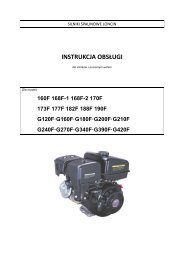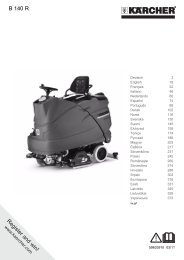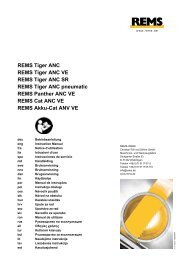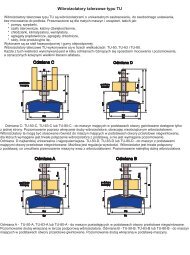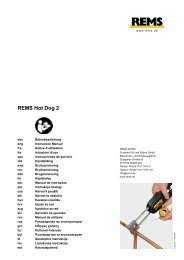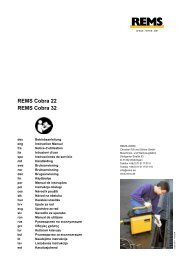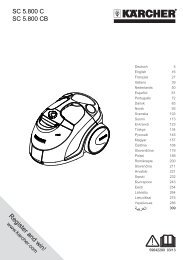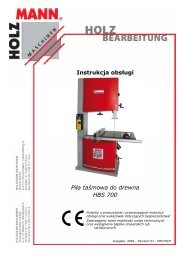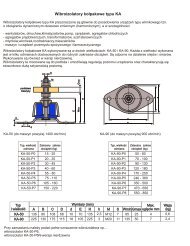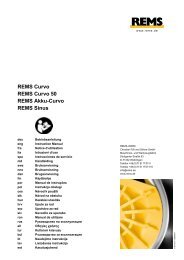REMS Power-Press E REMS Power-Press REMS ... - Megaobrabiarki
REMS Power-Press E REMS Power-Press REMS ... - Megaobrabiarki
REMS Power-Press E REMS Power-Press REMS ... - Megaobrabiarki
You also want an ePaper? Increase the reach of your titles
YUMPU automatically turns print PDFs into web optimized ePapers that Google loves.
engTranslation of the Original Instruction ManualThe respective latest sales literature applies for the use of <strong>REMS</strong> pressing tongs,<strong>REMS</strong> pressing tongs Mini, <strong>REMS</strong> pressing rings, <strong>REMS</strong> adapter tongs, <strong>REMS</strong>pressing heads and <strong>REMS</strong> expanding heads for the different pipe connection systems.If the system manufacturer alters components of pipe connection systems or marketsnew ones, their current application status must be enquired about at <strong>REMS</strong> (Fax+49 7151 17 07 - 110). Subject to modification without notice, errors and omissionsexcepted.Fig. 1 – 191 <strong>Press</strong>ing tongs2 Tong retaining bolt3 <strong>Press</strong>ure plate4 Locking pin5 <strong>Press</strong> rollers6 Housing grip7 Rotation direction lever8 Inching switch9 Pistol grip10 <strong>Press</strong>ing jaw11 <strong>Press</strong>ing contour12 BoltGeneral <strong>Power</strong> Tool Safety Warnings13 Reset button14 <strong>Press</strong>ing heads15 Expander16 Expanding head17 Expanding jaws18 Expanding mandrel19 Adapter tong20 <strong>Press</strong>ing ring21 <strong>Press</strong>ing segment22 <strong>Press</strong>ing contour (pressing ring orpressing segments)23 Battery charge indicatorWARNINGTo reduce the risk of injury, the user must read and understand the instructionmanual.Read all safety warnings and all instructions. Failure to follow the warningsand instructions may result in electric shock, fire and/or serious injury.Save all warnings and instructions for future reference.The term "power tool" in the warnings refers to your mains-operated (corded) powertool or battery-operated (cordless) power tool.1) Work area safetya) Keep work area clean and well lit. Cluttered or dark areas invite accidents.b) Do not operate power tools in explosive atmospheres, such as in the presenceof flammable liquids, gases or dust. <strong>Power</strong> tools create sparks whichmay ignite the dust or fumes.c) Keep children and bystanders away while operating a power tool. Distractionscan cause you to lose control.2) Electrical safetya) <strong>Power</strong> tool plugs must match the outlet. Never modify the plug in any way.Do not use any adapter plugs with earthed (grounded) power tools. Unmodifiedplugs and matching outlets will reduce risk of electric shock.b) Avoid body contact with earthed or grounded surfaces, such as pipes,radiators, ranges and refrigerators. There is an increased risk of electric shockif your body is earthed or grounded.c) Do not expose power tools to rain or wet conditions. Water entering a powertool will increase the risk of electric shock.d) Do not abuse the cord. Never use the cord for carrying, pulling or unpluggingthe power tool. Keep cord away from heat, oil, sharp edges or movingparts. Damaged or entangled cords increase the risk of electric shock.e) When operating a power tool outdoors, use an extension cord suitable foroutdoor use. Use of a cord suitable for outdoor use reduces the risk of electricshock.f) If operating a power tool in a damp location is unavoidable, use a residualcurrent device (RCD) protected supply. Use of an RCD reduces the risk ofelectric shock.3) Personal safetya) Stay alert, watch what you are doing and use common sense when operatinga power tool. Do not use a power tool while you are tired or under the influenceof drugs, alcohol or medication. A moment of inattention while operatingpower tools may result in serious personal injury.b) Use personal protective equipment. Always wear eye protection. Protectiveequipment such as dust mask, non-skid safety shoes, hard hat, or hearing protectionused for appropriate conditions will reduce personal injuries.c) Prevent unintentional starting. Ensure the switch is in the off-position beforeconnecting to power source and/or battery pack, picking up or carrying thetool. Carrying power tools with your finger on the switch or energising powertools that have the switch on invites accidents.d) Remove any adjusting key or wrench before turning the power tool on. Awrench or a key left attached to a rotating part of the power tool may result inpersonal injury.e) Do not overreach. Keep proper footing and balance at all times. This enablesbetter control of the power tool in unexpected situations.f) Dress properly. Do not wear loose clothing or jewellery. Keep your hair,clothing and gloves away from moving parts. Loose clothes, jewellery or longhair can be caught in moving parts.g) If devices are provided for the connection of dust extraction and collectionfacilities, ensure these are connected and properly used. Use of dust collectioncan reduce dust-related hazards.4) <strong>Power</strong> tool use and carea) Do not force the power tool. Use the correct power tool for your application.engThe correct power tool will do the job better and safer at the rate for which it wasdesigned.b) Do not use the power tool if the switch does not turn it on and off. Any powertool that cannot be controlled with the switch is dangerous and must be repaired.c) Disconnect the plug from the power source and/or the battery pack fromthe power tool before making any adjustments, changing accessories, orstoring power tools. Such preventive safety measures reduce the risk of startingthe power tool accidentally.d) Store idle power tools out of the reach of children and do not allow personsunfamiliar with the power tool or these instructions to operate the powertool. <strong>Power</strong> tools are dangerous in the hands of untrained users.e) Maintain power tools. Check for misalignment or binding of moving parts,breakage of parts and any other condition that may affect the power tool’soperation. If damaged, have the power tool repaired by qualified technicalpersonnel or an authorised <strong>REMS</strong> service shop before use. Many accidentsare caused by poorly maintained power tools.f) Keep cutting tools sharp and clean. Properly maintained cutting tools withsharp cutting edges are less likely to bind and are easier to control.g) Use the power tool, accessories and tool bits etc. in accordance with theseinstructions, taking into account the working conditions and the work tobe performed. Use of the power tool for operations different from those intendedcould result in a hazardous situation.5) Battery tool use and carea) Recharge only with the charger specified by the manufacturer. A chargerthat is suitable for one type of battery pack may create a risk of fire when usedwith another battery pack.b) Use power tools only with specifically designated battery packs. Use of anyother battery packs may create a risk of injury and fire.c) When battery pack is not in use, keep it away from other metal objects, likepaper clips, coins, keys, nails, screws or other small metal objects, thatcan make a connection from one terminal to another. Shorting the batteryterminals together may cause burns or a fire.d) Under abusive conditions, liquid may be ejected from the battery; avoidcontact. If contact accidentally occurs, flush with water. If liquid contactseyes, additionally seek medical help. Liquid ejected from the battery may causeirritation or burns.6) Servicea) Have your power tool serviced by a qualified repair person using onlyidentical replacement parts. This will ensure that the safety of the power toolis maintained.Specific Safety WarningsWARNING● Use personal safety equipment (e.g. goggles).● Avoid unnatural postures, and do not lean too far forward.● Before changing the pressing or expanding tools, pull the mains plug or take outthe battery!● The drive units develop a very high pressing force. For that reason, be particularlycareful. Keep all other persons away from the working area during working.● Hold the drive units only by the housing grip (6) and the pistol grip (9) during operation.Keep your hands away from moving parts (pressing area, expanding area)!● Never operate radial presses when the tongs shank (2) is not locked. Risk of fracture!● Always position radial presses with pressing tong, pressing tong Mini, pressingring on the press fitting at a right angle to the pipe axis. Never position it askew.● Do not start radial presses without pressing tong, pressing tong Mini, pressingring inserted. Do not start the pressing operation except to make a press joint.Unless counter pressure is applied by the press fitting, the drive unit or pressingtongs, pressing tongs Mini, pressing rings will be needlessly stressed.● Before using pressing tongs, pressing tongs Mini, pressing rings from othermanufacturers, check that they are suitable for the drive unit. Read and observethe instruction manuals of the pressing tong or pressing ring manufacturers.● Only operate axial presses with pressing heads fully inserted. Risk of fracture!● Always position axial presses with the pressing tongs on the compression sleevefitting at right angles to the pipe axis. Never position it askew.● Screw expanding heads as far as they will go onto the expander.● Do not attempt to repair damaged pressing tongs, pressing tongs Mini, pressingrings, adapter tongs, pressing heads or expanding heads. Risk of fracture!● Consult and comply with the instructions for installation and fitting of the system’smanufacturers.● This appliance is not intended for use by persons (including children) with reducedphysical, sensory or mental capabilities, or lack of experience and knowledge,unless they have been given supervision or instruction concerning use of theappliance by a person responsible for their safety. Children should be supervisedto ensure that they do not play with the appliance.● Only allow trained personnel to use the power tool. Apprentices may only operatethe power tool when they are over 16, when this is necessary for their trainingand when they are supervised by a trained operative.● Ensure the switch is in the off position before inserting battery pack. Insertingthe battery pack into power tools that have the switch on invites accidents.● Do not use the battery/charger at battery/charger temperatures or ambienttemperatures of ≤ 5°C/40°F or ≥ 40°C/105°F.● Do not dispose of defective batteries in the normal domestic waste. Take themto an authorised <strong>REMS</strong> after-sales service facility or to a reputed waste disposalcompany.


